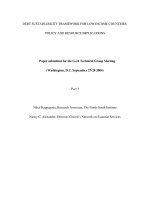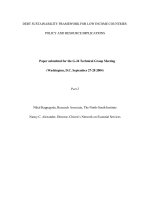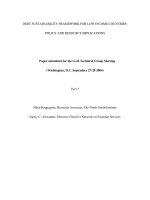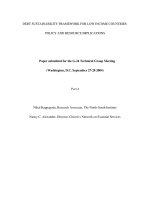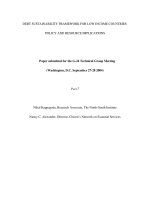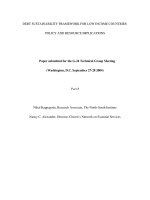Tài liệu DEBT SUSTAINABILITY FRAMEWORK FOR LOW INCOME COUNTRIES : POLICY AND RESOURCE IMPLICATIONS - Part 10 doc
Bạn đang xem bản rút gọn của tài liệu. Xem và tải ngay bản đầy đủ của tài liệu tại đây (109.7 KB, 15 trang )
DEBT SUSTAINABILITY FRAMEWORK FOR LOW INCOME COUNTRIES:
POLICY AND RESOURCE IMPLICATIONS
Paper submitted for the G-24 Technical Group Meeting
(Washington, D.C. September 27-28 2004)
Part 10
Nihal Kappagoda, Research Associate, The North-South Institute
Nancy C. Alexander, Director, Citizen’s Network on Essential Services
Annex 2
Country Performance Ratings for 2003
1
For each policy cluster in the CPIA, the Bank applies numerical
performance ratings from 1 (low) to 6 (high) and these are converted to
five “letter” grades. The reason for presenting the data this way is that
the Bank places each government in one of five quintiles, based upon
the quality of its performance in each area. Quintiles display the
performance of governments relative to one another, whereas the real,
undisclosed data present nominal scores. The following tables present
the World Bank’s aggregated performance ratings of low-income
borrowing governments relative to one another. While the letter grades
and the quintiles from which they are derived are not exact
representations of the numeric scores, they are still highly indicative.
The following tables present the World Bank’s aggregated performance
ratings of low-income borrowing countries relative to one another.
As stated, to produce each country’s overall performance rating, the
Bank applies a heavily-weighted “governance factor” to the weighted
average of the CPIA score (which counts for 80 percent of the overall
rating) plus the government’s portfolio performance score (which
counts for 20 percent). In other words, in order to obtain the IDA
country rating, the Bank applies the (absolute) rating of the “governance
1
Ibid footnote 16.
factor” in column “A” to the averaged (absolute) ratings in columns “B”
and “C.”
2
Rating criteria
3
The Bank rates each low-income country government on twenty criteria
using a numerical scale (from 1 to 6). The 2002 version of these criteria
is summarized as follows. Few changes have been made in the 2003
version.
Economic management
• Management of inflation and current account. Countries with the
highest rating (6) have not needed a stabilization program for 3
years or more. Countries with the lowest rating (1) have needed, but
have not had, an acceptable program for 3 years or more.
2
Some countries have not been rated and do not appear in any of the tables below, e.g., Afghanistan,
Liberia, Myanmar, Somalia, Timor-Leste. An entry of “N/R” indicates that the country was not rated in that
category.
3
Recent changes in the allocation system can be reviewed at: www.worldbank.org/ida
• Fiscal Policy. Countries with high ratings have fiscal policies
consistent with overall macroeconomic conditions and generate a
fiscal balance that can be financed sustainably for the foreseeable
future, including by aid flows where applicable.
• Management of external debt. Ratings take into account the
existence and amount of any arrears; whether and how long the
country has been current on debt service; the maturity structure of
the debt; likelihood of rescheduling, and future debt service
obligations in relation to export prospects and reserves.
• Management and sustainability of the development program.
Degree to which the management of the economy and the
development program reflect: technical competence; sustained
political commitment and public support and participatory processes
through which the public can influence decisions.
Structural policies
• Trade policy and foreign exchange regime. How well the policy
framework fosters trade and capital movements. Countries with a
high grade have low (10% or less) average tariffs (weighted by
global trade flows) with low dispersion and insignificant or no
quantitative restrictions or export taxes. There are no trading
monopolies. Indirect taxes (e.g. sales, excise or surcharges) do not
discriminate against imports. The customs administration is
efficient and rule-bound. There are few, if any, foreign exchange
restrictions on long-term investment capital inflows.
• Financial stability and depth. This item assesses whether the
structure of the financial sector, and the policies and regulations that
affect it, support diversified financial services and present a
minimal risk of systemic failure. Countries with a low rating have
high barriers to entry and banks’ total capital to assets ratio less than
8%. Countries with high scores have diversified and competitive
financial sectors that include insurance, equity and debt finance and
non-bank savings institutions. An independent agency or agencies
effectively regulate banks and non-banks on the basis of prudential
norms. Corporate governance laws ensure the protection of minority
shareholders.
• Banking sector efficiency and resource mobilization. This item
assesses the extent to which the policies and regulations affecting
financial institutions help to mobilize savings and provide for
efficient financial intermediation. Countries with high scores have
real, market-determined interest rates on loans. Real interest rates
on deposits are significantly positive. The spread between deposit
and lending rates is reasonable. There is an insignificant share of
directed credit in relation to total credit. Credit flows to the private
sector exceed credit flows to the government.
• Competitive environment for the private sector. This item
assesses whether the state inhibits a competitive private sector,
either through direct regulation or by reserving significant economic
activities for state-controlled entities. It does not assess the degree
of state ownership per se, but rather the degree to which it may
restrict market competition. Ideally, firms have equal access to entry
and exit in all products and sectors.
• Factor and product markets. This item addresses the policies that
affect the efficiency of markets for land, labor and goods. Countries
with high scores limit any controls or subsidies on prices, wages,
land or labor. Remaining controls are consistently applied and
explicitly justified on welfare or efficiency grounds.
• Policies and institutions for environmental sustainability. This
item
assesses the extent to which economic and environmental policies
foster the protection and sustainable use of natural resources (soil,
water, forests, etc.), the control of pollution, and the capture and
investment of resource rents.
Policies for social inclusion and equity
• Gender. This item assesses the extent to which the country has
created laws, policies, practices, and institutions that promote the
equal access of males and females to social, economic, and political
resources and opportunities.
• Equity of public resource use. This item assesses the extent to
which the overall development strategy and the pattern of public
expenditures and revenues favor the poor.
